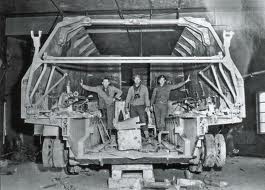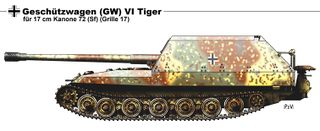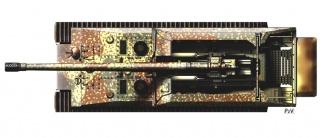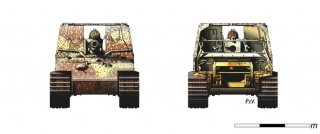GW Tiger
| Revisión de 03:24 23 ago 2014 Created page with "{{XboxTankData|Tank=G_Tiger |With its largest gun, this massive artillery hits for roughly 2,000 damage, but fires at only 1.25 rounds/min. Due to its large damage output, the..." | Última revisión de 10:37 25 oct 2016 1 revisión | |
(Sin diferencias)
| ||
Última revisión de 10:37 25 oct 2016
G_Tiger (Stock)
| 3600000 Precio |
| 500 Puntos de impacto |
| 59.28 / 60 kgPeso |
- Comandante
| 30/16/16Blindaje del chasis(frontal/laterales/trasero, mm) |
| 0/0/20Blindaje de la torreta(frontal/laterales/trasero, mm) |
| 650 CVPotencia del motor |
| 45 km/hLímite de velocidad |
| 14 grados/sVelocidad de rotación |
| 1400 Daño de proyectil estándar |
| 88 mmPerforación estándar del proyectil |
| 29.1 Tiempo en completar carga |
| 12 grados/sVelocidad de rotación torreta |
| 390 mCampo de vista |
| 310 mAlcance de radio |
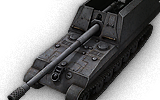
With its largest gun, this massive artillery hits for roughly 2,000 damage, but fires at only 1.25 rounds/min. Due to its large damage output, the GW Tiger is one of the most feared artillery on the field. Following the tradition of the other German artillery, the GW Tiger is fairly mobile (although noticeably less so than the Hummel or G.W. Panther) for its size and is capable of speeds of up to 35 km/h.
GW Tiger
Stock
| Nivel | Cañón | Peso (t) | Penetración media (mm) | Cadencia de tiro | Dispersión a 100 m | Tiempo de apuntamiento | ||
|---|---|---|---|---|---|---|---|---|
 |
VIII | 17 cm K72 (Sf) | 6750 | 88/95 | 1400/1400 | 2.06 | 0.72 | 7 |
| Nivel | Motor | Peso (t) | Potencia del motor (c.v.) | Probabilidad de incendio tras disparo | |
|---|---|---|---|---|---|
 |
VII | Maybach HL 210 TRM P45 | 750 | 650 | 20 |
| Nivel | Suspensión | Peso (t) | Límite de carga | Velocidad de giro (gra/s) | |
|---|---|---|---|---|---|
 |
VIII | GW-Tiger-Ketten Ausf. A | 25000 | 60 | 14 |
| Nivel | Radio | Peso (t) | Alcance de radio (m) | |
|---|---|---|---|---|
 |
III | FuG 5 | 0 | 310 |
Gerät 810
Recon
| Nivel | Cañón | Peso (t) | Penetración media (mm) | Cadencia de tiro | Dispersión a 100 m | Tiempo de apuntamiento | ||
|---|---|---|---|---|---|---|---|---|
 |
VIII | 17 cm K72 (Sf) | 6750 | 88/95 | 1400/1400 | 2.06 | 0.72 | 7 |
| Nivel | Motor | Peso (t) | Potencia del motor (c.v.) | Probabilidad de incendio tras disparo | |
|---|---|---|---|---|---|
 |
VIII | Maybach HL 230 TRM P45 | 750 | 870 | 20 |
| Nivel | Suspensión | Peso (t) | Límite de carga | Velocidad de giro (gra/s) | |
|---|---|---|---|---|---|
 |
IX | GW-Tiger-Ketten Ausf. B | 25000 | 64 | 16 |
| Nivel | Radio | Peso (t) | Alcance de radio (m) | |
|---|---|---|---|---|
 |
VI | FuG 7 | 0 | 415 |
GW Tiger II
Attack
| Nivel | Cañón | Peso (t) | Penetración media (mm) | Cadencia de tiro | Dispersión a 100 m | Tiempo de apuntamiento | ||
|---|---|---|---|---|---|---|---|---|
 |
IX | 21 cm Mrs 18/1 (Sf) | 5900 | 105/303/105 | 2000/1550/2000 | 1.49 | 0.86 | 7.5 |
| Nivel | Motor | Peso (t) | Potencia del motor (c.v.) | Probabilidad de incendio tras disparo | |
|---|---|---|---|---|---|
 |
VIII | Maybach HL 230 TRM P45 | 750 | 870 | 20 |
| Nivel | Suspensión | Peso (t) | Límite de carga | Velocidad de giro (gra/s) | |
|---|---|---|---|---|---|
 |
IX | GW-Tiger-Ketten Ausf. B | 25000 | 64 | 16 |
| Nivel | Radio | Peso (t) | Alcance de radio (m) | |
|---|---|---|---|---|
 |
IX | FuG 12 | 0 | 710 |
Compatible Equipment
Compatible Consumables
Player Opinion
Pros and Cons
Pros:
- Great range for stock gun (1400 m)
- Strong gun
- The ability to fire AP shells
- Large burst area for HE shells
- Shield on the rear may protect the rest of the tank if hit
Cons:
- Long reload
- Narrow gun arc
- Slow track traverse speed
- Poor gun range on top gun (1050 m), not able to cover corner areas near map borders
- Its large size makes it difficult to hide, due to a very large silhouette
Performance
The GW Tiger is the most powerful of tier 9 artillery, it has a great gun, and can fire AP shells which can wreak havoc on tier 10 heavies, the gun has no negative elevation, combined with a slow track traverse speed it is very hard to defend yourself in close quarter or if you are against enemy lights. But the tank can ram some tanks, mainly light tanks, it has the weight and frontal armor (50mm) to do that. Sixth sense is a must in this tank, you can also train the crew in camouflage, then do Brothers in Arms, a good skill for the driver is clutch lock braking, (to max out track traverse add 100-octane gasoline), in the gunner the skill snap shot helps with accuracy. The loaders can learn the perk Intution, which helps when switching shells out, and creates the chance that you don't have to wait the entire reload time to change shells, there is no good perks for the radio man, so do camouflage, BIA, repair. Always pay attention to the mini map, so you can keep up with your surroundings, so if a light is coming your way you can move before he gets to you.
Early Research
Suspension, then first engine, then gun, then top engine
Historical Info
In 1943/44, Krupp started production of the prototype, while full-scale production was to start in mid-1945 at a rate of 2 per month. The prototype was still incomplete at the end of the war.
Grille 17/21/30/42 had its armament mounted on the rail platform inside the hull. There were originally plans to have the guns dis-mountable but these plans were dropped in 1944 due to their complex nature and all of the GW Tigers were to be completed as normal SPGs. Each variant was also armed with two 7.92mm machine guns(source?). It would be operated by the crew of eight (Driver, Commander, Gunner, Radio Operator, and four Loaders). Powered by the Maybach HL230P30, the Grille would be able to travel at a maximum speed of 45 km/h with a range of 250km on the road and 150km cross country. Fuel capacity was to be 1000 liters.
The Grille was 13 meters long (with gun), 3.27 meters wide, and 3.15 meters high. Its armor protection ranged from 16mm Armor Plate(side) to 30mm Carbon Steel(front). The Grille 17 weighed 58,000 kg, but only carried 5 rounds of ammunition. The Grille 21 weighed 52,700 kg and carried only 3 rounds of ammunition. One prototype with a 17cm gun dismounted and resting nearby was almost completed in May of 1945, and was captured by British troops at Haustenbeck near Paderborn.
Historical Gallery
Sources and External Links
| USA | IIT57 • IIIM7 Priest • IIISexton I • IVM37 • VM41 • VIM44 • VIIM12 • VIIIM40/M43 • IXM53/M55 • XT92 |
| UK | IILoyd Gun Carriage • IIISexton II • IIISexton I • IVBirch Gun • VBishop • VIFV304 • VIICrusader 5.5-in. SP • VIIIFV207 • IXFV3805 • XConqueror Gun Carriage |
| Germany | IIG.Pz. Mk. VI (e) • IIISturmpanzer I Bison • IIIWespe • IVPz.Sfl. IVb • IVSturmpanzer II • VGrille • VIHummel • VIIGW Panther • VIIIG.W. Tiger (P) • IXGW Tiger • XGW Typ E |
| France | IIRenaultBS • IIILorraine39 L AM • IVAMX 105 AM mle. 47 • VAMX 105AM • V105 leFH18B2 • VIAMX 13 F3 AM • VIILorraine155 50 • VIIILorraine155 51 • IXBat.-Châtillon 155 55 • XBat.-Châtillon 155 58 |
| USSR | IISU-18 • IIISU-26 • IVSU-5 • VSU-122A • VISU-8 • VIIS-51 • VIISU-14-1 • VIIISU-14-2 • IX212A • XObject 261 |
| China | |
| Japan | |
| Czechoslovakia | |
| Sweden |
